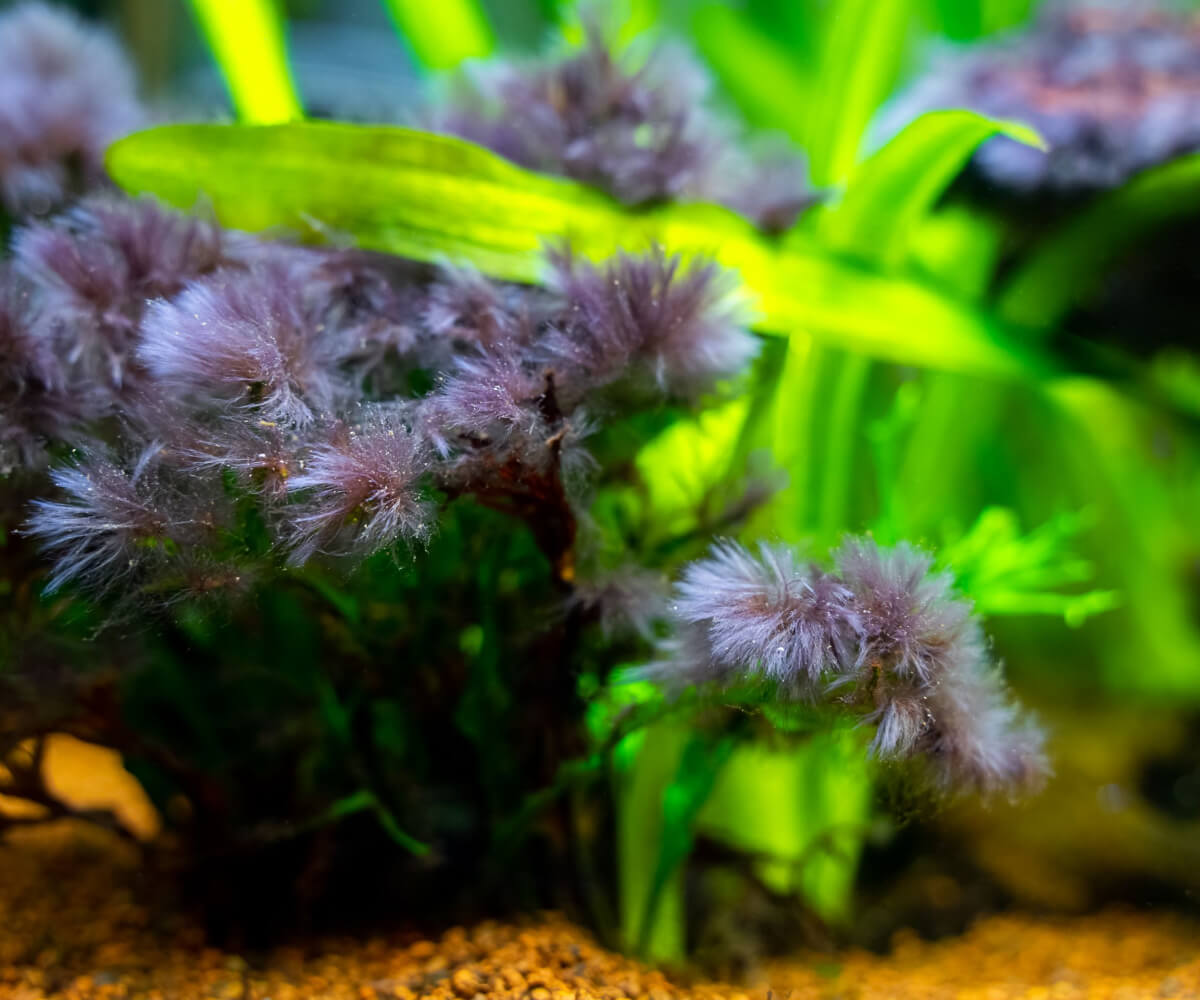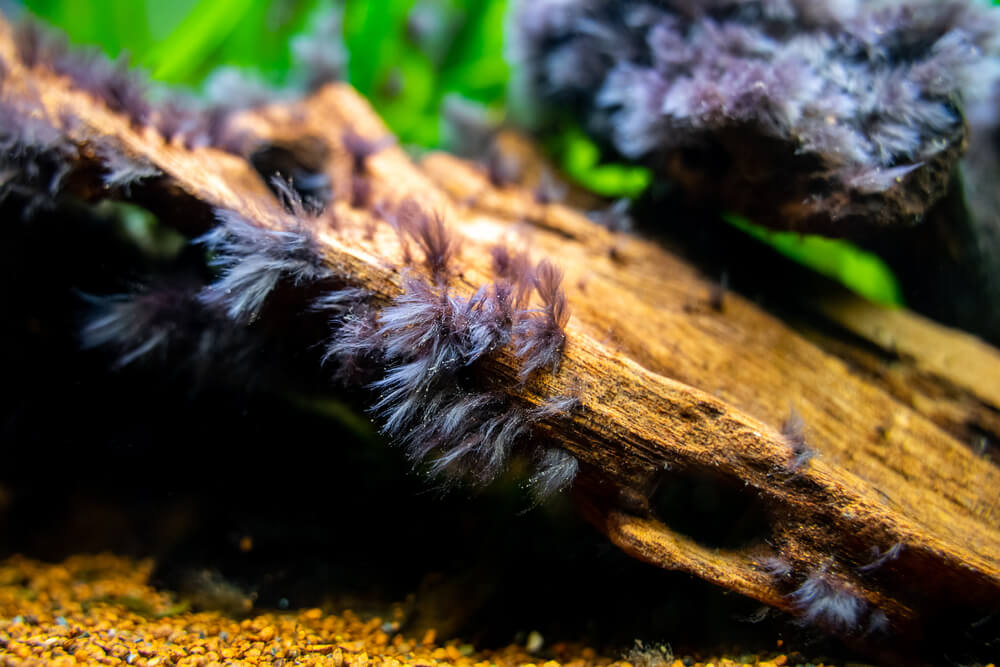Black Brush Algae: Removal, Causes & Treatment
Posted by on 02/23/2024
If you’re a freshwater aquarium owner, and especially if you're caring for a planted aquarium, then you’ll likely encounter black brush algae. This infamous algae, also referred to as black beard algae and abbreviated as BBA, is one of the most difficult types of algae to deal with.
In this post, we’ll go over what allows black brush algae to take over an aquarium, and we’ll provide guidelines on removal and treatment options. Let’s get started!
Table of Contents
January's Giveaways on Light Fish
What is Black Brush Algae?
Black Brush Algae is a type of Red Algae, a genus that comprises over 7000 different species, the majority of which can be found in marine environments. However, black brush algae is unique in that it can be found thriving in both freshwater and saltwater environments. Its scientific name Audouinella pays tribute to French naturalist Victor Audouin, who is perhaps best known for his discovery of the lemon-yellow tree frog.
Black Brush Algae typically grows in small tufts, giving the algae a ball-like appearance, and reproduces asexually via spores. The algae is smooth to the touch, and when fully grown can give a beard-like appearance to plants or aquarium hardscape, such as driftwood and stones.

Causes
Black Brush Algae typically takes over a tank when one or multiple of the following conditions are present:
- Too Much Light
- Not Enough CO2
- Low Plant Biomass
- Not Enough Flow
Black Brush Algae can take hold quickly if one of these conditions is available, even if for only a short period (for example, you forgot to turn on CO2 while you've left for vacation).
While plant nutrient deficiency is the most common cause of algae growth (plants are unable to grow without adequate nutrients), typically you'll see other types of algae when nutrient deficiency is present, such as hair, thread, and dust algae. This post assumes you are fertilizing your plants adequately. If plants are yellowing, we recommend reading up on nutrient-dosing strategies, such as the Estimative Index.
Treatment
To prevent Black Brush Algae from taking over, it's important to address the symptoms that enabled it to grow in the first place. It may take a few months to find the "sweet spot" in which black brush algae will not grow. Don't get discouraged! Every aquarium is different, and you'll need to experiment for quite a few weeks or months to get everything in balance.
Lighting
For lighting, consider reducing your lighting intensity, or reducing the duration of your photoperiod. If you have aquatic plants that demand strong lighting, consider renting a PAR meter to get accurate lighting measurements along the aquarium substrate. Once you've ensured your high-light plants are getting enough lighting, you can gradually reduce your photoperiod.
CO2
For CO2, you'll want to ensure an appropriate amount of gaseous exchange is occurring over 24 hours. If you're using a drop checker, ensure the drop checker is blue before your aquarium lights turn on. When the aquarium lights do kick in, the drop checker should be lime green in color. This color change represents a "pH drop" that ensures your tank is off-gassing an adequate amount of CO2 overnight.

Plant Biomass
Often ignored by new hobbyists, is plant biomass. Many hobbyists will pick up a few stems of beautiful plants, only to engage in a constant battle with algae.
You need to have A LOT of plants in a planted aquarium with strong lighting and CO2. We're talking 70% of your aquarium should be covered in aquarium plants! Okay, technically you may not need that much but it's a good rule of thumb! If you don't have a lot of plants, you'll need to reduce your light intensity and photoperiod until your aquatic plants start to fill out a bit. You can see how this can be a bit problematic since a nutrient-rich environment with CO2 and strong lighting drives the fastest amount of plant growth. You'll need to temporarily accept dimmer lighting and slower growth rates until your plants fill in. Then you can crank up your light intensity!
One important thing to note is the transition period for newly acquired plants. While planting heavily from the start can circumvent a plant biomass issue with black brush algae, newly added plants need time to adjust to your tank parameters. When adding new aquatic plants to your tank, keep your light intensity at moderate levels, and reduce your photoperiod to 5-6 hours a day for about a month. Otherwise, you'll be creating an ideal environment for black brush algae to take over! Once your aquatic plants have settled in a bit, you can slowly increase your lighting and CO2 injection rates.
Flow
Flow rates often go hand in hand with gaseous exchange. Without adequate flow, plants aren't able to absorb CO2 and nutrients in the water column. Additionally, CO2 isn't able to exit the aquarium as easily, reducing the amount of available oxygen in the water, a limiting factor for plant growth.
Luckily flow is relatively easy to fix. Aim for enough flow where your aquatic plants sway gently in the water column. The aquarium should also have a gentle ripple at the water's surface. If you have a very strong current, your tank will be well-oxygenated, but you may be off-gassing your CO2 too quickly. Too little current and your plant growth will be stagnant since they're unable to receive their required nutrients and CO2.
If your aquarium filter isn't providing enough flow, consider adding a powerhead to increase water movement throughout the tank.
Removal
Unfortunately, Black Brush Algae is one of the most difficult to remove types of algae, but fear not, there are a few things we can do to remove it!
If you notice black brush algae starting to form, the best thing you can do is to immediately reduce your lighting intensity, and re-evaluate the potential causes we've previously mentioned. If only a small amount of black brush algae has formed, you can usually manually remove it.
However, if you're battling a lot of black brush algae, we'll need to take more drastic measures.
The first option we recommend for black brush algae removal is known as the blackout method. To perform a blackout, you'll want to completely cover your aquarium with towels or black garbage bags. You'll want to ensure that no light is entering your aquarium. Leave the aquarium completely covered for 5-6 days. Plants and livestock will be fine during this period. Try not to uncover your tank, as no light must get into the aquarium. The goal is to "starve" the algae of light. Once the blackout period has ended, you can examine your black brush algae. If you notice it turning red (remember, black brush algae is technically a red algae!) or beginning to look dull in color, that means the algae is beginning to die off. You can then remove as much as you can manually, or by using a siphon. You may need to do 1-2 more blackouts depending on how much black brush algae is in your tank.
If the blackout method is proving ineffective, you can try a more unnatural approach, spot-treating the algae with a product known as Flourish Excel. This chemical is often used as a CO2 substitute in planted aquariums. It is quite potent and is capable of killing algae. Hobbyists will typically spot-treat black brush algae with a syringe filled with Flourish Excel.
Be very careful when doing this! Overdosing Flourish Excel can kill your plants and livestock. We recommend only adding 1 drop of Excel to each tuft of black brush algae. If you think you may have accidentally added too much Excel, perform 2-3 90% water changes to remove as much Excel as possible. Black brush algae will typically turn red, indicating its die-off 24 hours after a spot treatment.
Conclusion
That wraps up our guide on Black Brush Algae. While this algae is often a planted tank hobbyist's most feared opponent, you now have all the knowledge needed to combat this aggressive foe.
If you notice black brush algae forming, you don't need to go overboard removing every small piece you find. The blackout method, spot-treating with Excel, manual removal, and encouraging good plant growth is often enough to fully eradicate this type of algae.
It takes time to learn how to properly manage this algae in a planted tank, so don't get discouraged! Have you won the battle against black brush algae in your aquarium? Let us know in the comments, and be sure to visit our marketplace, where you can pick up new aquatic plants for your next aquascape.
January's Giveaways on Light Fish


